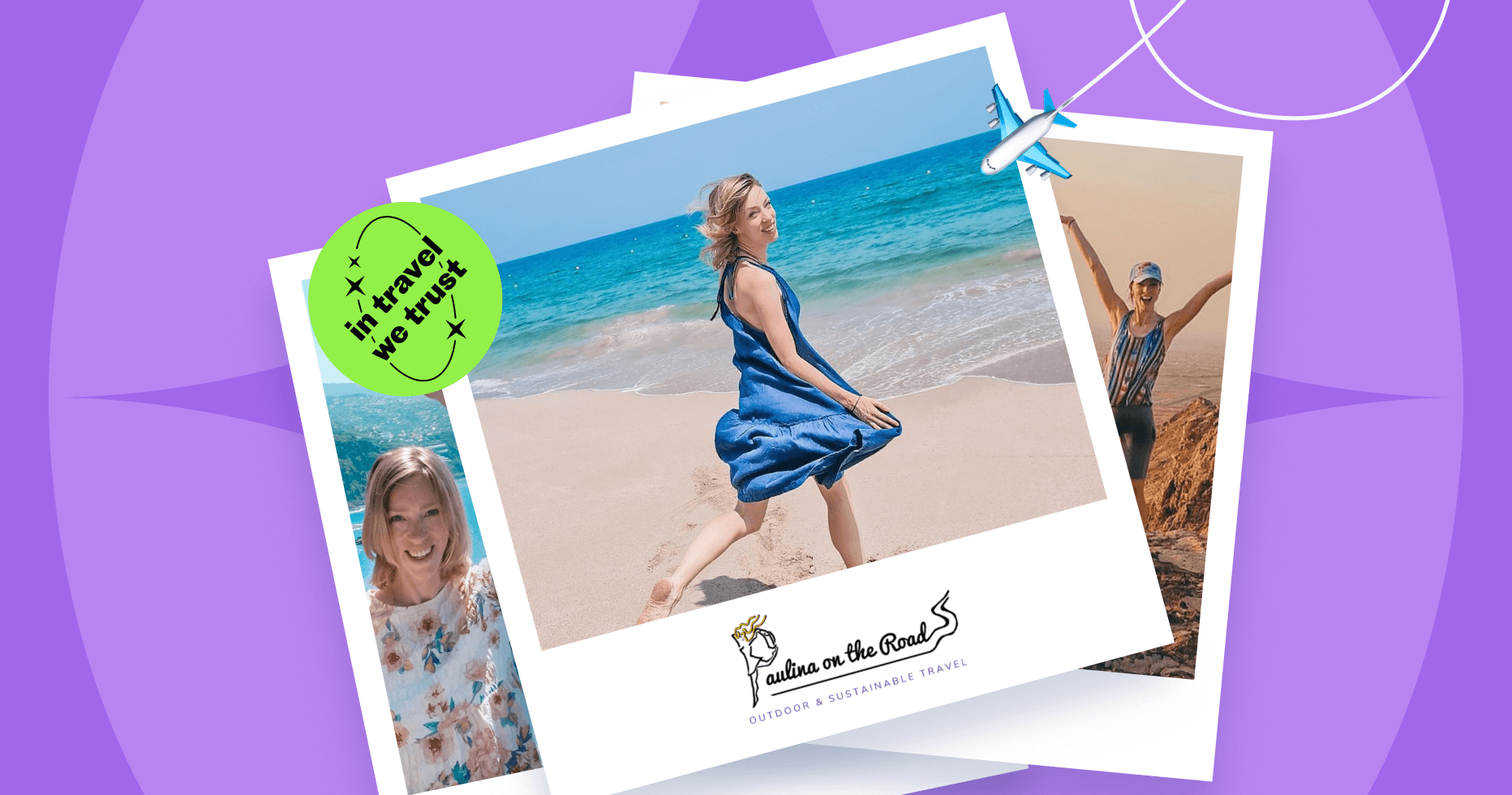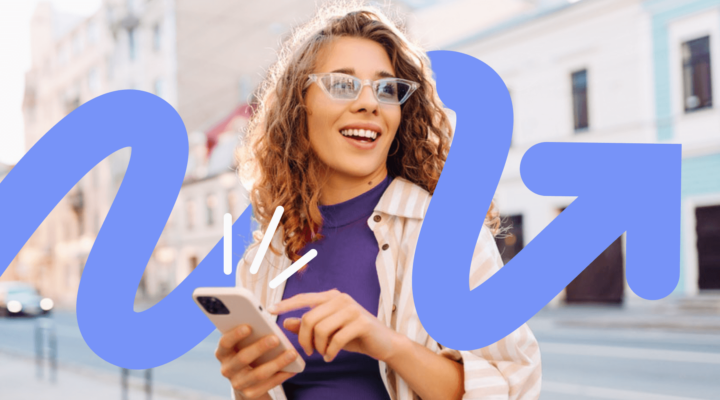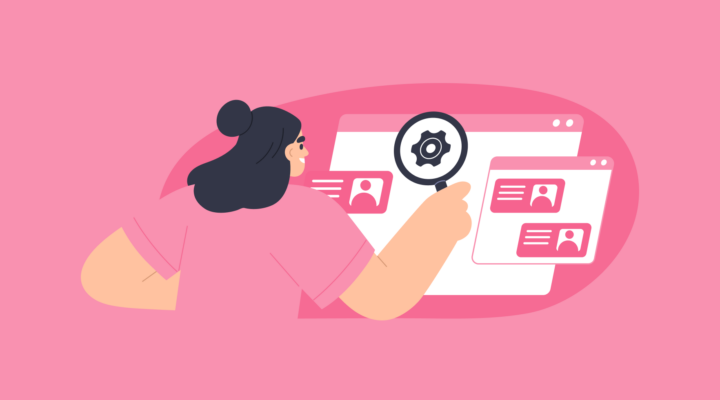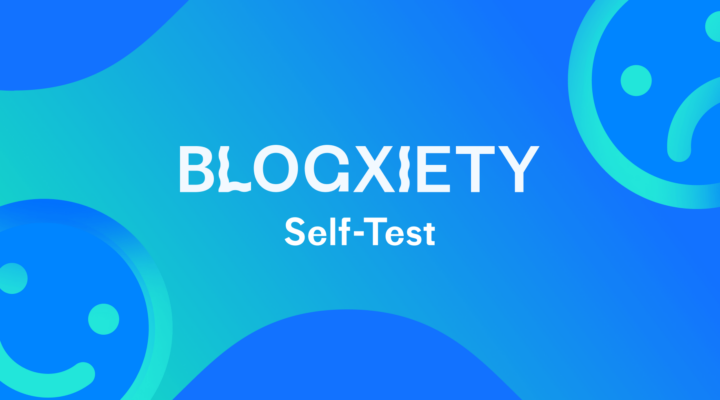How It All Began
In August 2016, I started my first travel blog, paulinaontheroad.com, while living in Spain. I saw bloggers traveling around the world and publishing posts, which inspired me to start my own blog. I particularly remember Alexandra Pereira, as a businesswoman, she was a major inspiration for me.
I was in Madrid at that time, working in tourism and event management. During the daytime, it was 35 to 40 degrees. The only place I had proper air conditioning was at the library. I sat there with my laptop and just started writing posts. All the time I got messages like: “Oh, where should I go for food?”, “Where should I stay in Spain”, “What should I visit”, and so on.
By that time, I was already visiting a lot of places in Spain and had seen so many places that I was mixing them up. In order to remind myself of my travels, I began to keep a travel diary and publish it on the net. These were very small articles. When I posted every article in English and in Spanish, my blog wasn’t monetized at all. Moreover, I didn’t do any SEO. These early posts were simply my personal and almost philosophical thoughts about traveling and stuff.
Then I saw that traffic suddenly picked up on my “10 Things to Do in Azores” article and asked myself, “Wow, what did I do in this article that I haven’t done in the others? How can I replicate this success?” Today, such articles are ubiquitous, but in 2016, this was still a rather new way of publishing. It was a game changer for me.
Now, I’m diversifying and run two websites. I started the second website about travel in the South of Spain, visitsouthernspain.com, two months before the start of the pandemic. At that time, I didn’t know if it was crazy or stupid, but it has started to pay off.
I was born and raised in Luxembourg, but due to my education, I moved around a lot. I studied in Brussels (Belgium), in Passau (Germany), and later in Malaga (Spain). All of my studies were always focused around literature and intercultural communication. Of course, you don’t leave university and say, “Hey, now I want to be a blogger”, but my studies allowed me to learn more about marketing and communication.
Before I came back to Luxembourg in 2020, I worked in the tourism sector in four different cities throughout Spain. When I saw that the blog was still growing, two months before COVID, I decided that I could be a full-time travel blogger. It couldn’t have been a worse moment to make the jump. Once the pandemic began, my traffic dropped to almost zero and my affiliate marketing income cratered as well.
My First Blog Income
In the beginning, blogging was more like a hobby. I didn’t really have the aspiration to monetize my website. However, after I left Spain to travel for six months and crossed the Atlantic Ocean by Boat HitchHiking, I changed my mind.
This world is so beautiful and I really wanted to see more of it. There’s so much to do, so much to see, and so many beautiful people to meet. I saw that other bloggers were earning a full-time income from blogging and I wanted to do the same. All of that pushed me to take blogging more seriously.
I spent a lot of time to migrate my blog to WordPress and begin the monetization process. It took time to realize how to do things correctly. I got some help with coding, but still had to research everything on my own. This wasn’t easy since, depending on the articles you read, you always find biased information.
But over time, after I started getting more clicks on ads, I realized the creative process wasn’t so important. While I really enjoyed this aspect of blogging, I learned that if you want to make a living from a travel blog, you need to let go of the philosophical articles and creative photos.
To earn a solid income, you need to provide what the reader wants. However, I save my philosophical captions for Instagram, which is where I reflect and talk directly to my audience. On my blog, I focus on providing useful information and writing articles that match the readers’ interests.
Approaches to Monetization
I can only roughly calculate my average RPM, as it changes based on the time of year, especially in the summer. It’s quite high and gets ridiculous in December. I would say that my RPM is currently $35.
I monetize my blogs with:
- Ads
- Affiliate marketing
- My own products
I have listed these in order of profitability. Advertising brings me the most revenue, followed by affiliate marketing income. I also created my own paid travel guide as well, which is just a tiny part of my income.
Like any travel blogger, I receive a lot of requests for guest posts. I’d say that I delete 95% of them automatically. However, when I see a genuine interest that would be a good fit, I accept. But this is a rare occurrence. The last time it happened was so long ago, so I don’t count selling links as one of my income streams.
Sometimes, I get requests such as “Hey, we’ll give you a backpack, can you review it?” If the product fits and I have time, I will write product reviews. However, I also wouldn’t consider that as an income stream because it’s very irregular.
Before the pandemic, I used to go on a lot of sponsored trips. I was paid well to create content on a couple of these trips, but in most cases, they were opportunities to create content in exchange for the invitation. These trips are awesome and you’ll definitely have some unique experiences and see the destination in a different way. However, you should be ready. It’s a lot of work to create an article and take those kinds of pictures. This is why I think twice about accepting these invitations.
With my second website, it took me around two years to reach $1,000 monthly income. My next goal is to increase my RPM, it would be awesome to earn $80 of revenue per 1,000 impressions. However, at the initial stage, I’m always just keeping producing content, keep going, and never giving up. For everyone who is just starting or isn’t yet earning a solid income, never give up! Just keep going. It’s not a fast process, as it can take a long time to properly monetize your website. But don’t give up!
Affiliate Marketing
For me, affiliate marketing has always been a bit hit and miss. I have tried several options to see if it works. As it’s not my main source of income, I allow myself to play around and be more flexible. For example, with the exception of my blogs, I added affiliate links to my newsletters. After all, it’s a straightforward process if you want to sell something with affiliate marketing. Add an affiliate link and that’s it.
Before the pandemic, the main income from travel affiliate programs was on the Booking.com affiliate program. Unfortunately, it’s still maybe 10% of what it used to be. Except for accommodations, I am monetizing content with everything that is related to transportation and outdoor gear.
Through Travelpayouts, I work with the Omio affiliate program as well. They offer flights, as well as ground transportation in Europe via buses and trains. I mostly sell bus and train tickets.
Join the Travelpayouts partnership platform
Join todayIf I see that an affiliate program isn’t performing well, I always look for alternatives and replace my existing links. Unfortunately, I didn’t start using the ThirstyAffiliates plugin right away, so link replacement used to be a headache. With this plugin, I can now quickly replace links as needed.
How to Place Affiliate Links
In terms of affiliate tools, I almost exclusively use affiliate links. For me, it’s more important that my website remains fast. If I add banners or widgets, it can slow down the loading speed. Second, I already have contextual ads, so if I add visuals as well, I think it will be too much for the reader.
I am not the kind of person that delves into click rates and so on. I simply look at my income and, if I see something working well, I just do more of that. I’m not sure if I place links in the best way, but I always place them organically in the text and add a call to action, such as:
- Check prices here
- Get your quote here
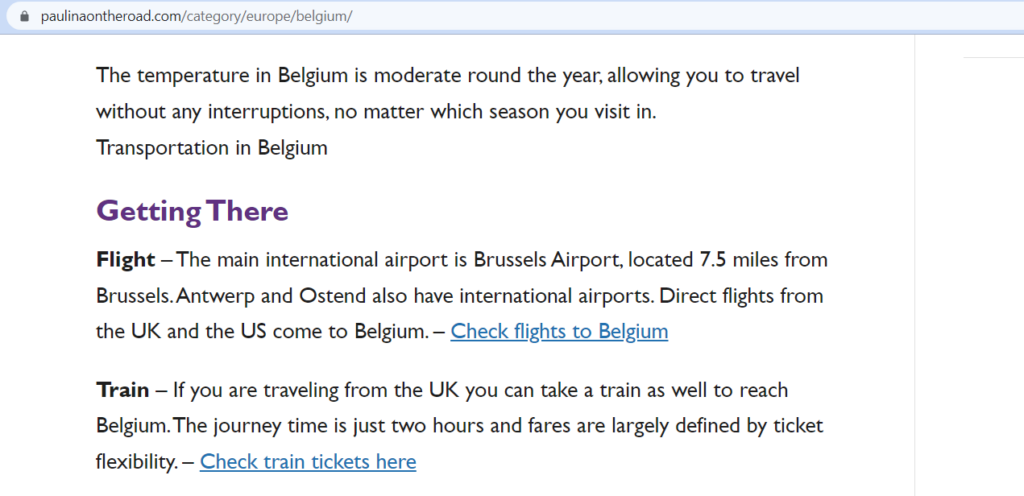
Adding a call to action is always a good idea. I also have tried the buttons. Honestly, I haven’t determined if one works better, so I alternate between them.
I think the best place for affiliate links is right at the beginning in the first 100 words or so. They also fit perfectly in comparison tables:
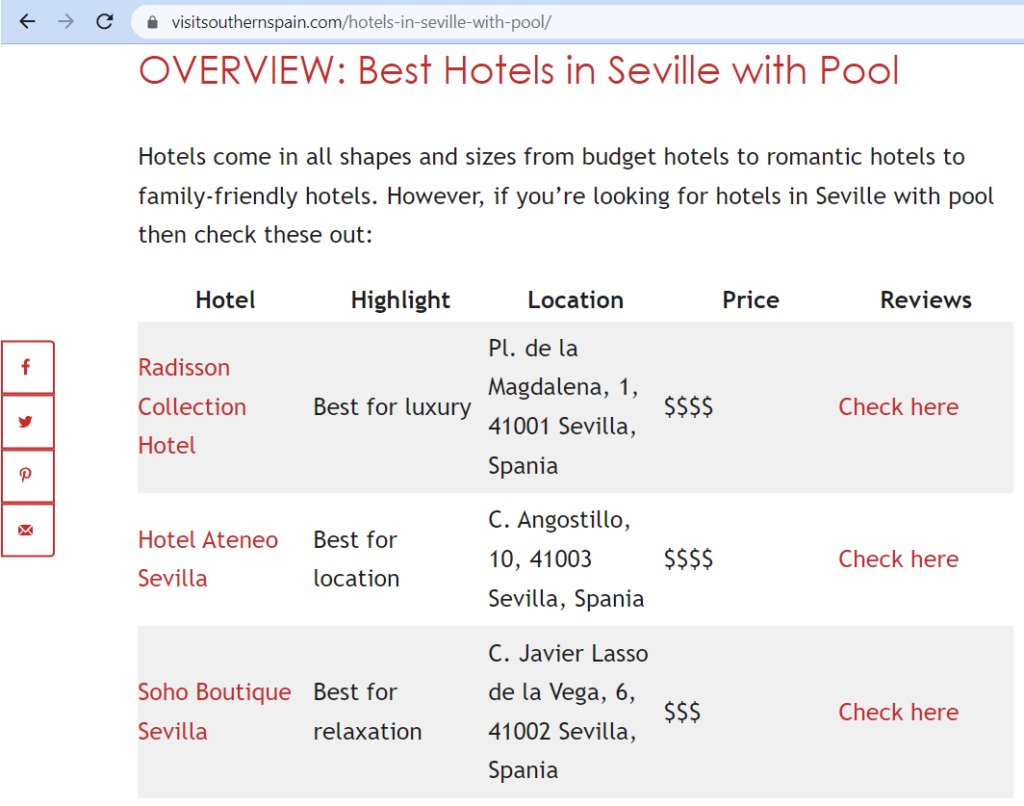
Niche vs General Travel Blog
I have two travel blogs:
If you check out my first website, paulinaontheroad.com, you can see that I have a category about Spain as well. However, unlike my second blog, paulinaontheroad.com contains more generic articles about Spain. I also have articles about other destinations, such as the Cape Verde, USA, and Europe.
I think you should always choose something that you enjoy first and niche down. For example, if you adopted a dog two years ago, why not make a website about dogs and, from there, narrow it down. Maybe it can be about Golden Retrievers or older dogs and so on. There is always a way to niche down.
Before choosing a niche, if you are considering monetization, check to see if your idea can be monetized. What affiliate elements can be added? Is there enough traffic to incorporate ads later on?
When I started my first blog, which is more general, I wanted to have a space to write about more generic topics and various destinations, including Spain. When I started my second website, I really wanted to have a website about the South of Spain because it’s a place that I really enjoy and that I know a lot about.
In addition to the blogs, I have a travel-related newsletter. I know some bloggers are really working hard on their newsletters, but mine is relatively small. I have around 600-700 subscribers right now. I collected these subscribers from my blog.
Traffic Sources
Organic traffic is the main traffic source for both of my websites. Before writing, I perform SEO research and check keywords with good potential. This helps me choose what to write about.
I am replicating successful methods. When I see that one article is doing well, I am always going to do more of this. The secret is quite simple: just replicate what has been doing well and keep doing it.
To get a better position in Google, sometimes, you may need to get links. I don’t buy links, but I sometimes exchange links with other bloggers. It all depends on your article and competition. Links aren’t obligatory for every page. If you need some links, you can check Facebook. There are plenty of groups, such as DNW – Making Money From Blogging, where you can simply say that you are looking for links or guest posting opportunities. In the latter case, you can write the article for somebody and, from that article, receive the link.
If you want to receive organic traffic, you should provide the reader with what they’re looking for. You should always focus on the reader’s intent. If there is a search volume on the keywords, such as “what to do in Dubai at night”, even if you personally are not a nightlife lover, you can write about this topic and attract new traffic. Meanwhile, if you’re a flower lover, it’s hardly worth writing about the flowers that grow in Dubai, since few people are looking for content on this topic.
Travel Content
If you run a niche website, topics should always fit your niche. You can start writing about Panama, but if your website doesn’t have any relation to Panama, it won’t make sense. When I am trying to niche down, I always choose topics that are related to my niche.
My recipe to choose the best topic for blog posts:
- Long-tail keywords
- Less competition
- Related to my niche
This is how I choose a topic to write about.
The biggest challenge is to scale once. Then you need to ask: How did that work? How can I multiply that? You need to decide how much you want to manage. Because, at some point, you’re just managing people. And that’s when you need to determine if you still enjoy the process or if you prefer to write more.
I know other bloggers that do it all by themselves, like me. I personally really like writing and taking pictures. I like all of it. But if you want to have a high traffic volume, you need to get help, which is the biggest challenge for personal blog owners.
When training a content assistant, you should teach them to basically copy your style. Even if someone assists you, everything that’s been published on the website should go through you. There shouldn’t be anything published without you involved. You must be reading it, checking it, and correcting it.
Having fun creating content is very important for me. If you turn yourself into an assembly line and get obsessed with the money, you may just lose six months of your life. I enjoyed content creation and still enjoy this process. Maybe it takes me longer to reach a decent income as a result, but enjoying my time is important to me.
Visual content is also a challenging question. Luckily, I have a massive database of my own pictures. Sometimes, I use photo stocks, such as Shutterstock or Canva, as well as an open-source platform, like Pixabay.
I believe the path I took with my blogs was right for me. But if I had a time machine, I would have considered monetization earlier. If I could give my past self a tip, I would tell myself not to listen to the first article or blog that you see. You always need to do your research. It took me a long time to realize this, but now I don’t hesitate to do my research.
Key Takeaways
- You should always choose something that you enjoy and niche down from there.
- Before making the final choice, check if that niche can be monetized. Which affiliate tools can be added? Is there enough traffic to include ads later on?
- The best place for affiliate links is right in the beginning (usually the first 100 words). They also fit perfectly in a comparison table.
- The ThirstyAffiliates plugin is a handy tool for link management that allows you to replace a link in just a couple of clicks.
- Adding a call to action to your affiliate links is always a good idea. You can alternate between links and banners.
- If you see that an affiliate program doesn’t perform well, always look for alternatives and replace links. You can find over 100 travel affiliate programs on the Travelpayouts platform.
- Sponsored trips are one of the advantages of travel blogging. Even though sponsored trips are awesome, you should be prepared before accepting one since it takes a lot of work to flesh out an article. As a result, you should think twice about whether to accept an invitation or not.
- If you are just starting out or haven’t achieved a steady income, never give up. Just keep doing and keep going. Properly monetizing is not a fast process. It may take a long time.
- When you see that one article is doing well, try to replicate that success and keep doing it.
- The best keywords for an article are long-tail keywords that are related to your niche and have low competition.
- It’s important to keep your website fast. Do not overload your site with heavy images and scripts.
- If you don’t have enough photos for an article from your travels, use Shutterstock or Canva, as well as open source platforms, such as Pixabay.
—
Want to share your story? Travelpayouts welcomes all bloggers with any travel-related experience. Write to us at an@travelpayouts.com with the following subject: “Story for the Travelpayouts Blog”.

